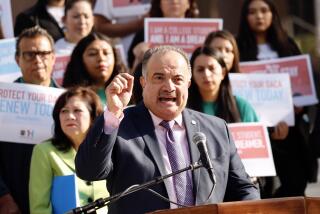Building a name for Dominguez Hills campus
Mildred Garcia never thought she had much of a future, especially in academia.
When she was 12, Garcia’s father died and she moved into a New York City housing project with her mother and six siblings. As a teenager, she worked part-time factory jobs. Two friends died young, one from AIDS and the other from a drug overdose.
“But I held to values taught by my parents,” Garcia recalled in a voice edged with a pronounced New York accent. “La unica herencia que una familia pobre le deja a sus hijos es una buena educacion. The only inheritance a poor family leaves its children is a good education.”
She mentioned this poignant advice during her May inauguration as president of Cal State Dominguez Hills, where she is known as an outgoing leader with a passion for supporting minority students and a penchant for St. John Knits and Prada purses.
The first Latina president in the 23-campus Cal State system, she is a Puerto Rican who was told by her high school counselor that “I wouldn’t make it through college.”
Now she is gearing up to lead the notoriously isolated Carson university into an era of aspiration and success. Her reputation as a problem-solver and agent of change with 30 years of experience in higher education administration may be sorely tested, according to faculty and university foundation officials.
Unlike most state universities, Dominguez Hills has stagnant enrollment rates, partly because of stiff competition from relatively nearby Cal State Long Beach. Founded in 1960, the school has long had a nagging reputation for being a “remediation campus,” a place where older students, not overachieving high school grads, come to reinvent themselves.
About 71% of its freshmen in 2007 needed remediation courses in English and math, the highest rates for such courses in the Cal State system. By comparison, about 23% of Cal State Long Beach’s freshmen needed remediation in both subjects that year.
“It seems staggering and negative,” said Amy Bentley-Smith, a Dominguez Hills spokeswoman. “But we get them that way, and then we help them achieve something great.”
To be sure, there is plenty to crow about. The 384-acre campus was built on what was once part of a Spanish land grant and, as Garcia likes to point out, has one of the most diverse student populations of any university its size west of the Mississippi.
It has an acclaimed music program and is the third-largest producer of teachers in the state. The campus recently launched a master’s program in nursing.
As Garcia, 56, noted with evangelistic fervor at her inauguration, “We will prove our pundits wrong and become stronger than we have ever imagined.” She vowed to stamp out forever “the image of Dominguez Hills as the best kept secret in Southern California.”
In an interview in her office, which is decorated with framed photos of relatives who know her as “Tia Millie,” Aunt Millie, she said, “We haven’t done a very good job of marketing what we do well.
“CSU Long Beach, for example, has a cool slogan, ‘The Beach is Hot!’ ” she said. “And while we don’t have Steven Spielberg, who went to Long Beach, we do have California Assembly Speaker Karen Bass. People should know that about us.”
Garcia, who took over as president in August, is already generating regional buzz. Hispanic Business magazine named her among the “100 Most Influential Hispanics” for 2007. In January, she was grand marshal of the Martin Luther King Jr. parade in Los Angeles.
Faculty and students still talk about the holiday party she held in December in the president’s house, near the campus. After all, it had been years since a university leader made proper use of the facility’s enormous kitchen designed to service gatherings of dignitaries and prospective supporters. It’s all part of creating a higher profile for the university.
“She’s got what it takes,” said George Schmeltzer, community director of the nonprofit Cal State Dominguez Hills Foundation. “She’s enthusiastic and looking out to broader horizons in terms of corporate and civic cooperation than we have in the past. She’s talking about marketing the university better and improving the quality of courses.”
Kate Fawver, an assistant professor of history and chairwoman of the Dominguez Hills Academic Senate, agreed. “We are on the cusp of something very great here; when we get this right, we will be a model urban university for the nation,” she said. “Changing our story begins at the top.”
Garcia epitomizes a new generation of Latina leadership. Born and raised in Brooklyn, she was the first in her family to go to college.
She earned an associate degree in legal secretarial sciences and business and a bachelor of science in business education from the City University of New York. She went on to earn a master’s in business education and higher education from New York University, then a master’s in education administration and a doctorate in education from Columbia University’s Teachers College.
She recalled driving to Columbia for her first course, then breaking down in tears in the car “because I didn’t see anyone who looked like me. I wondered, ‘Am I going to be able to do this?’ ”
She found a way, and has gone on to write books suggesting how others can do the same. In 1997, her book “Affirmative Action’s Testament of Hope: Strategies for a New Era” was published. She followed in 2000 with “Succeeding in an Academic Career: A Guide for Faculty of Color.”
Before coming to Dominguez Hills, she served as president of Berkeley College, a private New York City business school that attracts students who have difficulty staying in higher education because of job or family responsibilities.
At Dominguez Hills, she said her priorities include “recognizing our points of pride and sharpening our mission and image” -- starting with the “toro,” or bull, mascot, which appears in myriad forms. It may seem minor, but a single image will promote a consistent “brand” for the university.
“We are going to have one bull, not six,” Garcia said, “and it will be unveiled in January, along with our strategic plan.”
But more immediate challenges abound. With the Cal State system projected to receive about $386 million less than last year, the university is reeling from budget cuts, hiring freezes and fee increases. Daily parking rates were recently raised to $4 from the $3 set years ago to accommodate the university’s mostly working-class students.
Overall, faculty, students and local leaders generally praised Garcia’s initial efforts to pull the campus out of its doldrums and to aggressively partner with corporate and civic leaders throughout the South Bay.
On a recent weekday she lunched with three Hermosa Beach city officials, one of whom noted that “this is the first time in 15 years that an official from our city has been in the CSU Dominguez Hills president’s office.”
Among them was Councilman Michael Keegan, who recalled, “It was a very fruitful lunch meeting. President Garcia took copious notes.”
--
More to Read
Sign up for Essential California
The most important California stories and recommendations in your inbox every morning.
You may occasionally receive promotional content from the Los Angeles Times.











